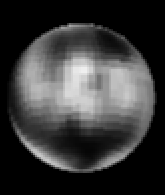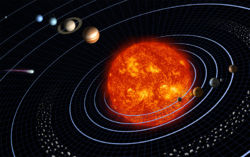Charon
 From Conservapedia
From Conservapedia | Charon | |
|---|---|
 | |
| Date of discovery | July 2, 1978 |
| Name of discoverer | James W. Christy |
| Name origin | mythic ferryman of the River Styx |
| Orbital characteristics | |
| Primary | Pluto |
| Order from primary | 1 |
| Perihadion | 19,640 km |
| Aphadion | 19,640 km |
| Semi-major axis | 19,640 km |
| Circumference | 123,402 km |
| Orbital eccentricity | 0.00 |
| Sidereal month | 6.38725 da |
| Avg. orbital speed | 0.23 km/s |
| Inclination | 0° to Pluto's equator |
| Rotational characteristics | |
| Sidereal day | 6.38725 da |
| Axial tilt | 0.0° |
| Physical characteristics | |
| Mass | 1.90 * 1021 kg (0.0318% earth) |
| Density | 1,650 kg/m³ |
| Equatorial radius | 586 km |
| Surface gravity | 0.278 m/s² (0.0283 g) |
| Escape speed | 0.58 km/s |
| Surface area | 4,580,000 km² (0.898% earth) |
| Mean temperature | 53 K |
- For the ferrymen of Hades of Greek mythology, see Charon (mythology).
Charon is the largest moon of the dwarf planet Pluto. It is so large, in fact, that some authorities hold that Pluto and Charon constitute a binary system because Pluto is not much more massive than is Charon.
James W. Christy of the United States Naval Observatory is credited with its discovery on July 2, 1978. NASA hopes to obtain more extensive images of Charon and other bodies in the Pluto system with its first extensive deep-space mission to the Pluto system, New Horizons.
Contents
- 1 Orbital and rotational characteristics
- 2 Young ice on Charon
- 3 References
- 4 Related links
Orbital and rotational characteristics[edit]

Note, however, that while Charon's revolution and rotation are technically prograde with respect to Pluto's own rotation, they are retrograde with respect to the Sun. This is because Pluto's own rotation is retrograde with respect to its own orbit.
Young ice on Charon[edit]
There seems to be conclusive evidence for young ice on Charon. Jason Cook of Arizona State University and his team of scientists have studied an icy coating on Charon, one of three moons orbiting Pluto. These researchers have found that the ice has crystalline structures, indicating that it has not been there for millions of years. Cosmic radiation from the Sun would break down the crystalline structures, so the ice must be younger than 100,000 years old.[1]
There are two possible explanations for this observation. Either the ice was there at the time Charon was formed and the moon is less than 100,000 years old, or the ice was formed by a more recent process and gives no indication of its age.
In order to fit the most widely believed evolutionary cosmologies, these researchers must justify the existence of young ice by theorizing a recent process. They propose that there is cryovolcanism over practically all the three million square mile surface of Charon.
Two other moons in the Solar System (Enceladus and Europa) have evidence of cryovolcanism along fault lines caused by “tidal squeezing” from Saturn and Jupiter respectively. Charon is not subjected to tidal forces from Pluto and the theorized cryovolcanism covers a greater area than this process would explain. Additionally, there are no observed geysers on Charon producing global ice.
Cook and his team avoid this objection by supposing that there is radioactive material causing heating of subsurface water and ammonia, producing many small ice geysers that are too small to be seen from Earth.
If the cosmology of creation science is applied to this observation, one would expect to see young ice whether it formed at the same time as Charon or whether it was formed by more recent processes. The explanation proposed by Cook, on the other hand, seems contrived as it progresses through layers of increasingly more complex and less verifiable theories.
The 2015 arrival of the New Horizons probe at Pluto will perhaps elucidate this argument by using its impressive suite of instruments to produce new evidence. Based on the reaction that we have seen to the evidence so far, we can safely say with Abraham,If they hear not Moses and the prophets, neither will they be persuaded, though one rose from the dead. Luke 16:31
This problem of young ice on Charon is only the tip of the iceberg (pardon the pun.) So far, astronomers have discovered over 1000 Trans-Neptunian Objects (TNOs) with a large number having young ice on the surface. The only observed geyser is the one spewing forth new theories of those seeking the magical shoe horn that will fit young surface ice on TNOs into the extant evolutionary cosmology.
References[edit]
- ↑ <http://www.gemini.edu/icemachine>
Related links[edit]
- Hamilton, Calvin J. "Entry for 'Charon'." Views of the Solar System, 2005. Accessed January 22, 2008.
- Entry for 'Pluto and Charon'." Solar System Exploration pages, NASA. Accessed July 22, 2008.
| |||||||||||||||||||||||||||||
↧ Download as ZWI file | Last modified: 03/01/2023 17:35:27 | 23 views
☰ Source: https://www.conservapedia.com/Charon | License: CC BY-SA 3.0
 ZWI signed:
ZWI signed:
 KSF
KSF